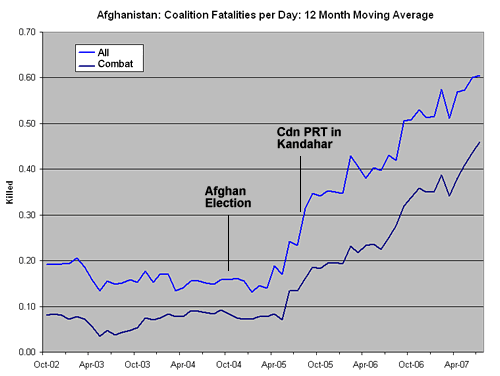Afstan: "So how did it come to this?"
Excerpts from an exceptionally cogent analysis by BruceR (returned from a tour as a Canadian Army mentor) at Flit--the whole a must-read, first part deals with the problems of operating with the ANA:
...
...
Looking back (see graph, above), one can see now mid-2005 was the inflection point.
As the graph shows quite clearly, after three years of near-quiescence, the insurgency in Afghanistan returned in strength, following the successful Western-supervised election confirming the Karzai presidency. In NATO, there was growing concern, however, that their underresourced effort to support the relegimitized government ended in practice at the outskirts of the capital, Kabul, and was having little effect beyond it. At the same time, an American military conducting its own terror-suppression, economy-of-force efforts in the South and East of the country, was eager to have Kabul's writ, and that of the International Security Assistance Force that supported the Afghan government, extended, particularly to the south of the country. In part, this has to be seen as an effort to free up some of its own resources, then desperately needed in the war in Iraq, as well. But there was also strong Afghan and international pressure to push the sphere of development beyond the capital.
The then-novel tool used by both Americans and their ISAF allies to address this issue was the Provincial Reconstruction Team, a node of military expertise emplaced in a provincial capital, and intended to develop governance and security in their immediate area with support from civilian and non-governmental agencies. PRTs were drawn from multiple nations, and often had different approaches to the task at hand. But it became clear almost immediately that, particularly in the south, the PRT as an organization would be barely capable of defending itself without help, let alone extend any kind of security umbrella to anyone else. That meant that army battalions would need to be deployed to support that work, as well. And the Afghan battalions weren't ready yet. Which meant Western battalions started pushing out to help their own PRTs. So what you saw in Helmand and Kandahar provinces, still the insurgents' battlefield of choice, was a British or Canadian battalion AND a PRT pushing out to relieve a harried U.S. battalion and taking over lead security responsibility for that province.
There was little if any discussion at this point about the road that was NOT being followed, that being only pushing development as far out as the Afghan security forces themselves could defend the "ink spot" (which to be fair, at this point would not have been very far). There were a couple reasons for this: the first being that the Afghan government itself was entirely unwilling to see Kandahar City or the Helmand Valley fall overtly under insurgent sway, which was certainly the most likely consequence of relying on their own resources at this point. The fight the Canadians and British subsequently found themselves in the south in the summer of 2006, faced with literally thousands of dedicated insurgents, showed without doubt that the insurgency, had Western battalions tried to withdraw completely from this area, easily would have overrun the country's second-largest city at that point. No, the alternative to Western forces in 2006 would have been outright insurgent control over a significant swath of the country: a full-on insurrection rather than an insurgency, in other words.
But that meant that, starting at the end of 2005 and the start of 2006, military mentoring of the Afghan army began playing a deadly game of catch-up, in the middle of what was already a medium-tempo war in much of the country: pushed out, regardless of readiness or capability, to be the "Afghan face," with the hope that "on-the-job" training and colocation with vastly more powerful and capable Western forces would enable them to correct their shortcomings. In practice, of course, it largely obscured, or exacerbated them...
The onset of a robust and active anti-government resistance, however, meant that the terms of reference of all our efforts to help Afghans had profoundly changed, and it's fair to say everyone involved was slow in seeing how much. Hindsight shows that the Afghan army and nation were now in a fight for their literal lives: a lot of the "nice-to-haves" in Afghan development that had been tolerable before 2006 probably needed to be jettisoned at this point, but there was no one in a position to make that case. For instance, substantial efforts continued to be poured into training local police forces as a criminal investigatory arm, rather than what they now would have to become in a warzone, a supportive and flexible paramilitary, whose efforts and the Afghan army's would have to be closely interconnected: hundreds of poorly armed police in shoddily defended police stations have since paid the price for those distractions with their lives...
Military advisory efforts are part and parcel of counterinsurgency, and will likely remain with us for some time. Our counterinsurgency manuals define victory as the point where the fight can be handed off to reliable indigenous forces; that implies a significant effort in their creation each time this kind of war is fought. But the experience in both Afghanistan and Iraq to date can hardly instill great confidence in anyone that the process is a simple or well-understood one...












0 Comments:
Post a Comment
<< Home